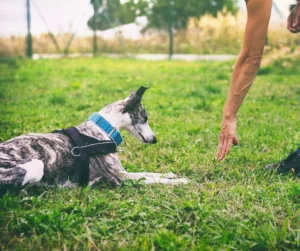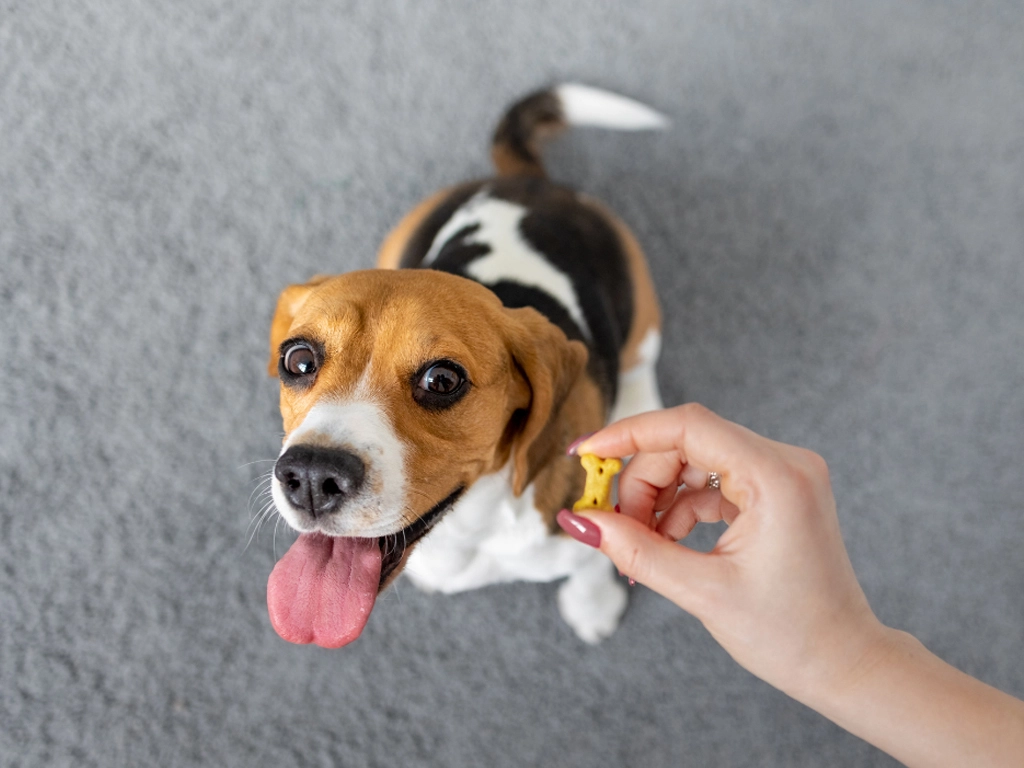Unlocking the Path to a Well-Behaved, Happy Dog. The Quest for Canine Excellence
Introduction: The Quest for Canine Excellence
Navigating the ever-evolving landscape of dog training, it’s imperative to opt for methods that not only deliver lasting results but also contribute to a happy and emotionally balanced canine. Positive reinforcement dog training stands as a champion in this realm. This comprehensive guide aims to give you the insights and techniques required to master this exceptional training approach.
The Unparalleled Science Behind Positive Reinforcement
The theoretical foundation of positive reinforcement dog training rests on the groundbreaking work of behavioural psychologist B.F. Skinner. Within the framework of operant conditioning, this method emphasizes rewarding good behaviour, thereby increasing the probability of its repetition. Scientifically, the action of adding a favourable reward to encourage a behaviour is termed as positive reinforcement.
Key Components of Effective Positive Reinforcement Dog Training
Identifying High-Value Rewards: The Linchpin of Successful Training
 The concept of a high-value reward is pivotal in positive reinforcement dog training. These are not just your run-of-the-mill treats or toys; these are stimuli that your dog finds irresistibly appealing. The high value of such rewards substantially increases the likelihood of your dog engaging in the desired behaviour again. For instance, if your dog savours a particular gourmet treat or is enamoured with a specific squeaky toy, these become indispensable tools in your training arsenal. The allure of the high-value reward facilitates rapid, effective, and lasting learning.
The concept of a high-value reward is pivotal in positive reinforcement dog training. These are not just your run-of-the-mill treats or toys; these are stimuli that your dog finds irresistibly appealing. The high value of such rewards substantially increases the likelihood of your dog engaging in the desired behaviour again. For instance, if your dog savours a particular gourmet treat or is enamoured with a specific squeaky toy, these become indispensable tools in your training arsenal. The allure of the high-value reward facilitates rapid, effective, and lasting learning.
Insight into Reward Choice: Tailoring to Individual Preferences
One size does not fit all when it comes to rewards. Just as humans have preferences, dogs do too. The efficacy of a high-value reward is significantly amplified when tailored to your dog’s specific likes and dislikes. This becomes especially important in private dog training, where the training regimen is customised to the individual dog and can be very challenging. Always be prepared to rotate the type of high-value rewards to maintain your dog’s interest and motivation.
The Critical Role of Timing in Reward Dispensation: Milliseconds Matter
Timing is not just important; it’s paramount. The immediacy with which a reward follows a desired behaviour dictates the strength of the association formed in your dog’s mind. This is known as the “contiguity principle,” wherein the closer the reward is to the act, the more likely the behaviour will be repeated. In practical terms, aim to deliver the reward within seconds of the desired behaviour to solidify the positive association and contribute to lasting results.
Consistency: The Imperative for Coherent Communication
If there’s one factor that can thwart your positive reinforcement training efforts, it is inconsistency. For the training to yield lasting results, rewards must be dispensed reliably and predictably. This is true not only in the initial training stages but also in later reinforcement schedules, where variable rewarding might be introduced. Consistency ensures that the dog doesn’t get mixed messages, which could potentially lead to confusion and slow down the learning process.
Marker Signals: Bridging the Gap
A marker signal, often a clicker or a specific word like “yes”, serves as a communication bridge between the dog’s action and the impending reward. The marker clearly identifies the correct behaviour at the moment it occurs, offering a crystal-clear indication of what specific action earned the reward. This technique is particularly beneficial in shaping more complex behaviours and sequences.
The Balancing Act: Reward Magnitude and Frequency
While high-value rewards are the cornerstone of positive reinforcement, their effectiveness can be fine-tuned by adjusting the magnitude and frequency. Smaller treats or shorter playtimes can be employed for simpler tasks, while more substantial rewards (aka Jackpots) can be reserved for challenging commands or significant behavioural milestones.
By incorporating these nuanced components into your positive reinforcement strategy, you elevate your dog training regimen from merely effective to profoundly transformative, ensuring not just an obedient but a truly happy dog.
Applications: Where Positive Reinforcement Truly Flourishes
Mastering Basic Obedience Commands
 Positive reinforcement is not just a buzzword; it is the bedrock for imparting foundational obedience skills. Whether it’s “sit,” “stay,” or “heel,” these basic commands are the cornerstones of any well-behaved dog’s repertoire. Using high-value rewards and immaculate timing, these commands can be easily inculcated within a short period, thus fostering a happy dog who not only listens but actively engages with their owner.
Positive reinforcement is not just a buzzword; it is the bedrock for imparting foundational obedience skills. Whether it’s “sit,” “stay,” or “heel,” these basic commands are the cornerstones of any well-behaved dog’s repertoire. Using high-value rewards and immaculate timing, these commands can be easily inculcated within a short period, thus fostering a happy dog who not only listens but actively engages with their owner.
Advanced Obedience: Beyond the Basics
Once the basics are soundly in place, one can venture into more advanced forms of obedience training. These could involve complex tasks like retrieving items, walking off-leash, or even responding to hand signals without verbal cues. Due to its flexible and adaptable nature, positive reinforcement is uniquely positioned to successfully guide these more advanced training stages, leading to a highly skilled and adaptable canine companion.
Addressing Behavioural Issues: A Comprehensive Solution
The efficacy of positive reinforcement is not confined to just teaching basic or advanced commands; it also permeates into solving more intricate behavioural issues. Excessive barking, chewing, or jumping are not just nuisances; they may indicate deeper emotional or psychological concerns. Positive reinforcement provides a humane approach to understanding and rectifying these issues, offering an alternative to punitive methods that can often exacerbate the problem rather than solve it.
Specialised Training Regimens: Agility, Therapy, and More
In the realm of more specialised training arenas like therapy dog certifications or canine sports, positive reinforcement remains a key driving factor. The central motivation instilled through positive reward systems creates dogs that are not only highly trained but also deeply invested in the task at hand. This leads to superior performance and higher levels of job satisfaction for both the dog and the trainer.
Puppy Socialisation: A Critical Period
The puppy phase is a crucial window for socialisation, and positive reinforcement offers an ideal approach. Introducing your puppy to various experiences, environments, and beings while associating these exposures with positive rewards ensures that the young dog grows up to be a well-adjusted adult. These early experiences create a lifetime of good behaviour and adaptability, hallmarks of a well-socialised, happy dog.
Fear and Anxiety: Transforming Emotional Responses
One of the often-underappreciated aspects of positive reinforcement is its role in fear and anxiety alleviation. The method is particularly useful in counter-conditioning, wherein a dog learns to associate previously fear-inducing stimuli with positive experiences. This transformative ability provides owners with a powerful tool for mitigating phobias, separation anxiety, and other stress-related behaviours in dogs.
The Prolific Benefits: Lasting Results and Emotional Well-being
Choosing positive reinforcement in your dog training toolkit yields long-term benefits. These include:
- Enhanced Learning Retention: The reinforcement of good behaviour culminates in lasting results, with your dog internalizing the positive actions.
- Emotional Prosperity: By sidestepping punitive measures, you contribute positively to your dog’s emotional well-being. This is particularly important for a happy dog.
- Strengthening the Bond: This strategy establishes a fortified emotional connection between you and your dog, a crucial factor often overlooked in dog training.
Case Studies: Real-world Evidence and Academic Endorsements
The effectiveness of positive reinforcement is not anecdotal. A multitude of case studies and rigorous research validate its utility. The American Veterinary Society of Animal Behaviour and other esteemed institutions champion this method for its ethical and humane approach.
Conclusion: The Incontrovertible Path Forward
The merits of positive reinforcement dog training are unquestionable. This approach provides a scientifically validated, ethical, and highly effective mechanism for not just teaching basic obedience but also for tackling complex behavioural issues. Whether you’re embarking on private dog training or looking to educate your canine companion in a group class, positive reinforcement ensures a happy, well-behaved dog with lasting results.



